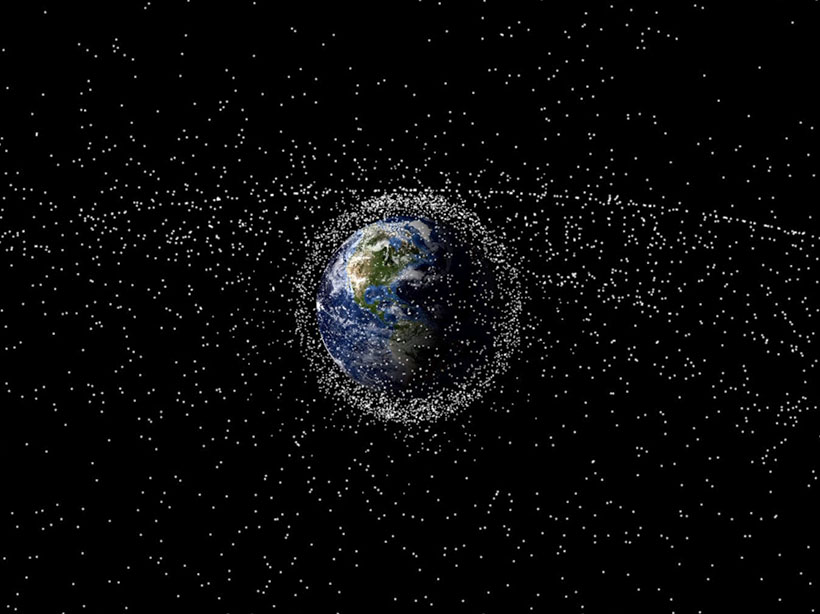
Looking up at a clear night sky, we see the dark heavens sprinkled with starlight. But those twinkling white dots are not all celestial bodies.
In 2015, for example, a team of researchers noticed something that at first appeared to be an asteroid. They launched a ground-based observational campaign to identify the object, using (among other methods) the recording of light curves, which measure the brightness of an astronomical object over time. The researchers found that the object was actually a piece of “Snoopy,” a missing Apollo 10 lunar module, which was classified as WT1190F.
WT1190F is just one of many, many pieces of space junk orbiting our planet. Space junk is defined as anything artificial that clogs up space near Earth, including defunct satellites and used rocket stages, as well as smaller objects such as solar panels, antennas, and even chips of paint. According to a U.S. Strategic Command database, Earth is orbited by more than 20,000 pieces of debris larger than a softball and about 100,000 pieces larger than a penny.
Carolin Frueh, an assistant professor of aeronautics and astronautics at Purdue University, was one of the researchers observing WT1190F and has continued researching space debris and ways to track it.
With funding sources like the Air Force Office of Scientific Research and NASA, Frueh and a team of researchers from Purdue have been developing identification methods that rely on astrodynamics, the study of the motion of artificial bodies moving under the influence of gravity. Frueh’s team uses optical data from light curves as well as simple and complex mathematical models.
Frueh and her team are identifying space debris to diagnose satellite integrity and assess the danger debris can cause to other satellites and the threat it could potentially pose to Earth.
“As a rule of thumb,” Frueh said, “anything that’s smaller than 2 tons in weight usually burns up [on reentry to Earth’s atmosphere].”
The bigger danger posed by space debris, Frueh said, is to functioning satellites, including those dedicated to GPS, weather forecasts, and information and communications technologies. “If we were to have too much debris,” Frueh said, “we wouldn’t be able to operate our satellites anymore.”This “fog” or “belt” of space debris might not lead us to the catastrophic series of events explained by the “Kessler syndrome”—also known as collisional cascading—which was illustrated in the 2013 Alfonso Cuarón movie Gravity, where each collision between space objects can generate further debris that could generate further collisions.
However, collisions between space debris and satellites are not just cinematic. In 2007, a piece of a micrometeoroid and orbital debris particle hit the space shuttle Endeavour’s radiator during one of its missions, and in 2013, a Russian Ball Lens in the Space (BLITS) nanosatellite was hit by a fragment of a satellite that China had intentionally destroyed in 2007.
Diagnosis and Detection of Space Debris
By tracking the fluctuating brightness of individual pieces of debris, Frueh and her team are able to trace and assess patterns. Light curves are most informative, she said, when researchers know about the object’s shape and how it rotates—data that aren’t always available to researchers as debris often is smaller parts of satellites that are easily confused with each other. Was the debris part of the solar panel, or was it part of the antenna?
“It’s a bit like detective work,” Frueh said. “You’re trying to piece different parts of evidence together to then make a statement.”
Héctor Socas-Navarro, a senior scientist at the Instituto de Astrofísica de Canarias who was not involved in the new research, said that using light curves to evaluate space junk is a “very clever idea.”
As satellites rotate, he explained, “the light that we get from a satellite changes because the amount of light it reflects from the Sun changes.” So if something happens to a satellite, say, a solar panel breaks off because of a collision, the sunlight being reflected by the satellite is going to change, too—change that can be recorded in the satellite’s light curves.
Light Curve Limitations
Socas-Navarro pointed out the limitations of the light curve method, however. “We can probably be sensitive only to really big events,” he said. “There’s subtle things you might not be able to see.” For example, it might be difficult to determine characteristics like the exact shape and size of the objects by using light curves.
Frueh agreed. “We are always too far away to get details of the objects.”
Her team’s end goal is to create “awareness of what is out there. And then ultimately feeding in how we can avoid this debris in the first place.”
—Camilo Garzón (@CamiloAGarzonC), Science Writer
"light" - Google News
July 30, 2020 at 08:20PM
https://ift.tt/30apGjQ
Flickers of Light Help Map the Space Junkyard - Eos
"light" - Google News
https://ift.tt/2Wm8QLw
https://ift.tt/2Stbv5k
Bagikan Berita Ini














0 Response to "Flickers of Light Help Map the Space Junkyard - Eos"
Post a Comment